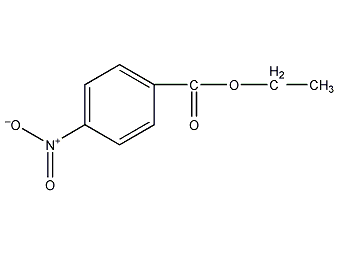Ethyl p-Nitrobenzoate Ethyl p-Nitrobenzoate


Structural formula
| Business number | 02GG |
|---|---|
| Molecular formula | C9H9NO4 |
| Molecular weight | 195.17 |
| label |
4-Ethyl nitrobenzoate, Ethyl p-nitrobenzoate, 4-(Ethoxycarbonyl)nitrobenzene, 4-Nitro-benzoicacythylester, Benzoic acid, 4-nitro-, ethyl ester, Benzoic acid, p-nitro-, ethyl ester, Ethyl nitrobenzoate, para ester, Ethyl para-nitrobenzoate, p-Nitro-benzoicacythylester, Rarechem Al Bi 0193 |
Numbering system
CAS number:99-77-4
MDL number:MFCD00007351
EINECS number:202-786-2
RTECS number:DH5600000
BRN number:1912879
PubChem ID:None
Physical property data
1. Properties: Colorless or light yellow needle-like crystals.
2. Density (g/mL, 20℃): Undetermined
3. Relative vapor density (g/mL, air=1): Undetermined
4. Melting point (ºC): 57
5. Boiling point (ºC, normal pressure): 186.3
6. Boiling point (ºC, mmHg): Undetermined
7. Refractive index: Undetermined
8. Flash point (ºC): Undetermined
9. Specific rotation (º): Undetermined
10. Autoignition point or ignition temperature (ºC): Undetermined
11. Vapor pressure (mmHg, ºC): Undetermined
12. Saturated vapor pressure (kPa, ºC): Undetermined
13. Heat of combustion (KJ/mol): Undetermined
14. Critical temperature (ºC): Undetermined
15. Critical pressure (KPa): Undetermined
16. Log value of oil-water (octanol/water) partition coefficient: Undetermined
17. Explosion upper limit (%, V/V) : Undetermined
18. Lower explosion limit (%, V/V): Undetermined
19. Solubility: Easily soluble in ethanol and ether, insoluble in water
Toxicological data
Acute toxicity: Mouse peritoneal cavity LD50: 250mg/kg;
Acute toxicity:
Oral LD50 2050mg/kg (mus)
2660 mg /kg(rat)
Main irritant effects:
On skin: May cause inflammation.
In eyes: May cause irritation
Sensitization: No known sensitizing effects.
Ecological data
General�Notes
Water hazard level 1 (German regulations) (self-assessment via list) This substance is slightly hazardous to water.
Do not allow undiluted or large amounts of product to come into contact with groundwater, waterways or sewage systems. .
Do not discharge materials into the surrounding environment without government permission.
Molecular structure data
1. Molar refractive index: 49.20
2. Molar volume (cm3/mol): 155.6
3. Isotonic specific volume (90.2K ): 407.3
4. Surface tension (dyne/cm): 46.9
5. Dielectric constant:
6. Dipole moment (10-24cm3):
7. Polarizability: 19.50
Compute chemical data
1. Reference value for hydrophobic parameter calculation (XlogP): None
2. Number of hydrogen bond donors: 0
3. Number of hydrogen bond acceptors: 4
4. Number of rotatable chemical bonds: 3
5. Number of tautomers: none
6. Topological molecule polar surface area 72.1
7. Number of heavy atoms: 14
8. Surface charge: 0
9. Complexity: 215
10. Number of isotope atoms: 0
11. Determine the number of atomic stereocenters: 0
12. Uncertain number of atomic stereocenters: 0
13. Determine the number of chemical bond stereocenters: 0
14. Number of uncertain chemical bond stereocenters: 0
15. Number of covalent bond units: 1
Properties and stability
Avoid contact with strong oxidizing agents.
Storage method
Store in a cool, ventilated warehouse. Keep away from fire and heat sources. should be kept away from oxidizer, do not store together. Equipped with the appropriate variety and quantity of fire equipment. Suitable materials should be available in the storage area to contain spills.
Synthesis method
Obtained from the esterification of p-nitrobenzoic acid and ethanol.
Purpose
Used as an intermediate in organic synthesis. In the pharmaceutical industry, it is used to produce local anesthetics benzocaine, tetracaine hydrochloride and antitussives for cough relief.
